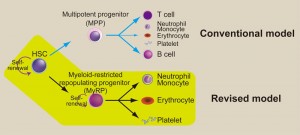Discovery of unexpected hematopoietic differentiation pathway Novel self-renewing lineage-restricted progenitors

The hematopoietic system that produces blood is maintained all through life by hematopoietic stem cells (HSCs). Hierarchical relationships exist among HSCs, their progeny, and mature blood cells. In the current model for hematopoiesis (the creation of blood cells), multipotent self-renewing HSCs, which can turn into a variety of types of blood cells and renew themselves as stem cells, initially give rise to multipotent progenitors (MPPs) with loss of the ability to self-renew. MPPs then produce common myeloid progenitors and common lymphoid progenitors in a stepwise manner. In this way, stem cells gradually become more and more specialized and lose the ability to turn into other cells. Despite wide acceptance of this concept, however, evidence from which hierarchical relationships are inferred is somewhat scanty and not definitive.
In the current study, Professor Hiromitsu Nakauchi and his research group at the Institute of Medical Science, the University of Tokyo, first developed a transgenic mouse line in which a variety of blood cells (T and B cells and neutrophils, but also erythrocytes and platelets) are labeled by Kusabira-Orange fluorescent protein to determine this hierarchical relationship. Using a single-cell transplantation of the mouse line, the research group unexpectedly found a new type of cell that is able to self-renew: myeloid-restricted progenitors with long-term repopulating activity (MyRPs), which are lineage-committed and so can only give rise to megakaryocytes, megakaryocyte-erythroid cells, or common myeloid cells. Paired daughter-cell assay combined with single-cell transplantation revealed that HSCs can give rise to MyRPs via asymmetric division.
These results show that loss of self-renewal and stepwise progression through specific differentiation stages are not essential for lineage commitment of HSCs. This novel concept is of critical importance not only for the field of hematopoiesis research but also the field of stem cell research and for developmental biology in general, and may contribute to research into treatments for leukemia and other diseases of the blood system.
Press release [pdf] (Japanese)
Paper
Ryo Yamamoto, Yohei Morita, Jun Ooehara, Sanae Hamanaka, Masafumi Onodera, Karl Lenhard Rudolph, Hideo Ema, Hiromitsu Nakauchi,
“Clonal analysis unveils self-renewing lineage-restricted progenitors generated directly from hematopoietic stem cells”,
Cell Online Edition: 2013/8/30 (Japan time), doi: 10.1016/j.cell.2013.08.007.
Article link
Links
The Institute of Medical Science
Center for Stem Cell Biology and Regenerative Medicine, Institute of Medical Science








